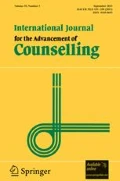Abstract
The migration of South Asians to the Western hemisphere calls for a more flexible approach to integrate traditional South Asian healing resources into the practice of counseling. Through an analysis of primary textual and secondary sources, this paper delineates the Sikh model of the person, suffering, and healing. The paper concludes by drawing parallels with Western counseling theory, and a case vignette to illustrate how the Sikh spiritual tradition can be integrated with Western psychotherapy.
Similar content being viewed by others
REFERENCES
Coward, H. C. (2000). Scripture in the World Religions. Oxford: One World.
Doabia, H. S. (1998). Sacred Nitnem [Daily Prayers]. Amritsar, India: Singh Brothers.
Gaines, A. (1992). Ethnopsychiatry: The cultural construction of professional and folk psychiatries. Albany, NY: SUNY Press.
Grewal, J. S. (1990). The Sikhs of the Punjab. New York: Cambridge University Press.
Guru Granth Sahib. (Damdami Version). Amritsar, India: Sri Gurmat Press. (Original work published 1706 C.E.)
Ibrahim, F., Ohnishi, H., & Sandhu, D. S. (1997). Asian American identity development: A culture specific model for South Asian Americans. Journal of Multicultural Counseling and Development, 25, 34-50.
Ishiyama, F. I., & Westwood, M. J. (1992). Enhancing client-validating communication: Helping discouraged clients in cross-cultural adjustment. Journal of Multicultural Counseling and Development, 20, 50-63.
Ivey, A. (1979). Counseling psychology: The most broadly-based applied psychology speciality. The Counseling Psychologist, 8(3), 3-6.
Johnson, A. W., & Nadirshaw, Z. (1993). Good practice in transcultural counseling: An Asian perspective. British Journal of Guidance and Counseling, 21(1), 20-29.
Kaur, J. (1985). The concept of man in Sikhism. Arlington Heights: Gurmat Publishers.
Kohli, S. S. (1974). Sikh ethics. New Delhi, India: Munshiram Manoharlal Publishers.
Martz, E. (2002). Principles of Eastern philosophies viewed from the framework of Yalom's four existential concerns. International Journal for the Advancement of Counseling, 24, 31-42.
Maskeen, S. S. (1990). Guru Joti [The Light of the Guru]. Amritsar, India: Singh Brothers.
Maskeen, S. S. (1993). Guru Chintan [Reflecting on the Guru]. Amritsar, India: Singh Brothers.
McCormick, R. (1996). Culturally appropriate means and ends of counseling as described by the First Nations people of British Columbia. International Journal for the Advancement of Counseling, 18, 163-172.
Morjaria, A., & Orford, J. (2002). The role of religion and spirituality in recovery from drink problems: A qualitative study of AA members and South Asian men. Addiction, Research, and Theory, 10(3), 225-256.
Nayar, K. (2004). The Sikh diaspora in Vancouver: The three generations amid tradition, modernity, and multiculturalism. Toronto: University of Toronto Press.
Nwachuku, U., & Ivey, A. (1991). Culture specific counseling: An alternative training model. Journal of Counseling and Development, 70, 106-111.
Paranjpe, A. C. (1996). Some basic psychological concepts from the intellectual tradition of India. Psychology and Developing Societies, 8(1), 7-27.
Sembhi, S., & Dein, S. (1998). The use of traditional healers by Asian psychiatric patients in the UK: A pilot study. Mental Health, Religion, and Culture, 1(2), 127-133.
Singh, A. (1970). Ethics of the Sikhs. Patiala, India: Punjabi University.
Singh, G. (1993). Sri Guru Granth Sahib [English Version]. New Delhi, India: World Book Center. (Original work published 1706 C.E.)
Singh, J. (2000). Discovering divine love in the play of life. Journal of Contemporary Sikh Studies [Surrey].
Singh, N. (1990). Philosophy of Sikhism. New Delhi, India: Atlantic Publishers.
Singh, R. (1975). Glimpses of the Divine Masters. New Delhi, India: International Traders Corporation.
Singh, S. (1982). Philosophical foundations of the Sikh value system. New Delhi, India: Munshiram Manoharlal Publishers.
Torrey, E. F. (1972). The mind game: Witch doctors and psychiatrists. New York: Emerson Hall.
Author information
Authors and Affiliations
Corresponding author
Rights and permissions
About this article
Cite this article
Sandhu, J.S. The Sikh Model of the Person, Suffering, and Healing: Implications for Counselors. International Journal for the Advancement of Counselling 26, 33–46 (2004). https://doi.org/10.1023/B:ADCO.0000021548.68706.18
Issue Date:
DOI: https://doi.org/10.1023/B:ADCO.0000021548.68706.18




